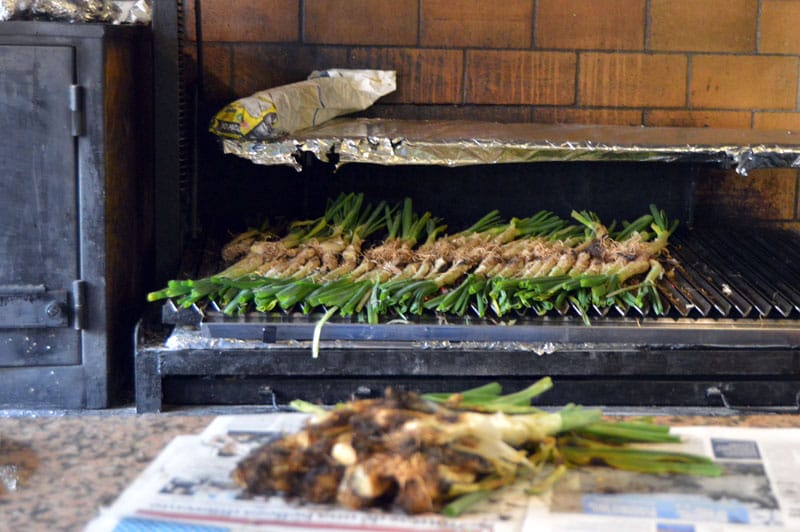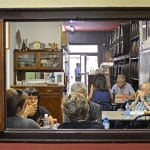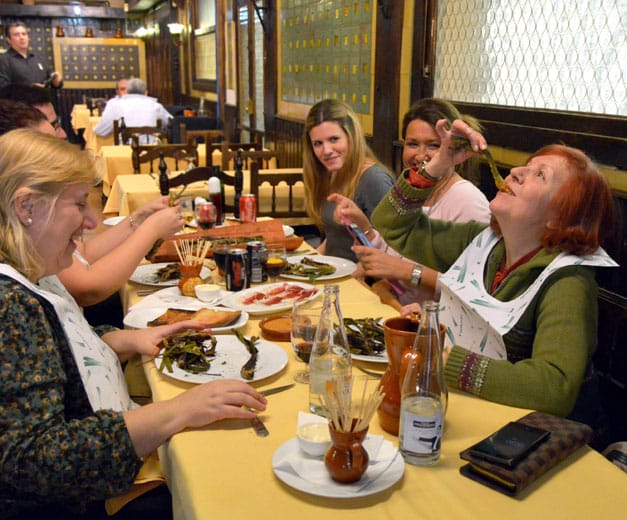Editor’s note: We regret to report that Can Manel has closed.
We don’t mind winter in Catalonia because it means the return of calçots, our beloved spring onions, and calçotadas, the wonderful celebrations that bring people together to eat them. While tradition usually calls for calçot eating to take place in the countryside, there are plenty of places to enjoy them in Barcelona as well. Since 2012, when Can Manel was reopened by the new owners Joel Balagué and Ana Roig, this homey eatery near the Sants train station has become a point of reference for the urban calçotada.
In the spirit of traditional calçotadas, Can Manel prepares a grilled lunch for a group (these onion feasts are not the kind of thing you do solo), with a tasting of this fragrant and sweet specialty. Calçots are typically grilled or barbecued, peeled and then dipped in a special sauce similar to romesco that is made from a picada (chopped mixture) of nuts with tomato, nyora (a dried red pepper), garlic, olive oil and bread. Generally, in addition to the onions, which serve as the appetizer, lunch also includes some butifarra (Catalan pork sausages cooked with peppers) and other grilled dishes. The point of the feast is not just to eat, but to thoroughly enjoy the time spent with friends (and of course to document the occasion with photographs to post to social media). It’s a socio-gastronomical celebration.

What we love about the calçotadas at Can Manel is their mix of pitch-perfect elements: the proper atmosphere of the rustic neighborhood restaurant, great service, the charcoal and pinewood grill, which imbues all the food with a touch of smoke and flame, the wonderful homemade sauce of almonds, walnuts and hazelnuts and, of course, the calçots themselves. The restaurant gets its onions from a farmer in Valls, which is where the best specimens are grown. They’re always fresh, full of flavor and a good size.
Can Manel excels at grilled meat (pork, lamb, veal, sausages, rabbit – one can even order a favorite chop with some advance notice), fish and vegetables, but these are not the only options. The restaurant offers two main seasonal menus; in winter the specialties are calçots, artichokes and snails, while in summer, there are salads, baked fish (cod with mongetas del ganxet, sea bass, gilt head bream, etc.), seafood and rice preparations and paellas (seafood paella, paella del senyoret, in which all the seafood comes already shelled and shucked, and a vegetable version).
Balagué and Roig carefully select every ingredient they use, ensuring they’re all of the highest quality. For the limited time they’re available, artichokes will be PGI (Protected Geographic Indication) from El Prat, in Catalonia, until their season ends and they are replaced by artichokes from the neighboring PGI of Tudela, whose season lasts longer. The butifarras and the rabbits come from small producers in Balagué’s village of Térmens, in Lleida.

With the raw materials so carefully chosen, thoughtful cooking is of the utmost importance. The artichokes are cut in half, sprinkled with salt, pepper and olive oil and placed directly on the grill to help those seasonings better penetrate the vegetables and enhance their flavor. The snails are the local variety bover, prepared two exceptional ways: a la gormanda calls for the mollusks to be cooked in a sauce and then finished a la llauna, or grilled in a pan over embers, while cargols a la Catxipanda has them cooked with butifarra, eggplant, red pepper and a white wine reduction and served in a clay casserole. The former is creamy and rich, a favorite among customers; the latter is bold in flavor without being spicy.
Can Manel is the kind of place that makes us wish winter would last just a little longer.
 March 10, 2022 Casa Nepalesa
March 10, 2022 Casa Nepalesa
When Tanka Sapkota, originally from Nepal, arrived in Portugal 25 years ago, Lisbon was […] Posted in Lisbon July 23, 2015 Yelo
July 23, 2015 Yelo
Editor’s note: It’s Cool Treats Week at Culinary Backstreets, and today we head to […] Posted in Tokyo August 23, 2019 Bar Code
August 23, 2019 Bar Code
Wooden wine barrels with taps, shabby old furniture, noisy antiquated fridges, soda […] Posted in Barcelona
Published on February 11, 2015
Related stories
March 10, 2022
LisbonWhen Tanka Sapkota, originally from Nepal, arrived in Portugal 25 years ago, Lisbon was a very different city. There were no Nepalese restaurants and the only momo people knew of at that time was the King of Carnival (Rei Momo). Tanka says there were only four people from Nepal in the country, including him. “And…
July 23, 2015
TokyoEditor’s note: It’s Cool Treats Week at Culinary Backstreets, and today we head to Tokyo, where a shaved-ice shop keeps 'em lining up late into the night. Yelo, Roppongi’s kakigori (shaved ice) mecca, summoned the faithful with free samples on April 1 like some kind of cool April Fool’s joke for the not-quite-warm weather. The…
Join us for a walk along Barcelona’s urban wine route!
August 23, 2019
BarcelonaWooden wine barrels with taps, shabby old furniture, noisy antiquated fridges, soda siphons from the 1960s… these are the building blocks of Barcelona’s classic bodegas. Formerly shops that sold bulk wine, liquor and ice, these bodegas survived the Spanish Civil War, social conflicts, food shortages, financial crises and, of course, modernity, with their essence intact,…



















































































